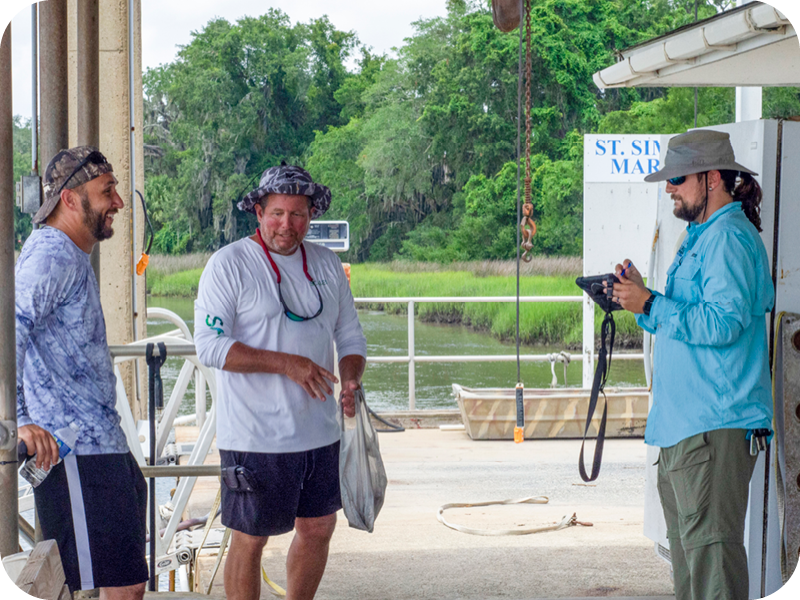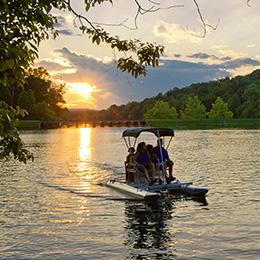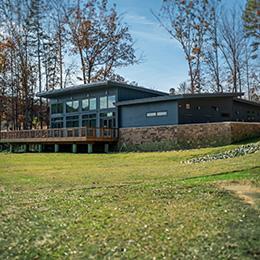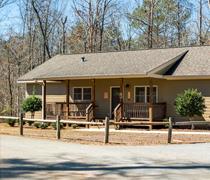
Surveying Marine Recreational Finfish Anglers in Georgia
CRD staff works in conjunction with the federal National Oceanic and Atmospheric Administration’s (NOAA) Fisheries to conduct surveys of coastal Georgia anglers and for-hire charter and headboat captains. These surveys are part of NOAA Fisheries’ Marine Recreational Information Program (MRIP), and are used to produce estimates of finfish catch (including fish released and those retained as harvest) as well as numbers of angler fishing trips (effort). Every three to four years, angler expenditure questions are included to estimate the economic impact of marine recreational fishing. These data, along with commercial fisheries and other research data, are used to track trends in fishing effort and landings, determine appropriate regulations (e.g., size and bag limits), provide catch data for evaluating the health of the fisheries, and inform fishery management plans.
What are the main components of the marine recreational fisheries surveys?
Data from three separate surveys are combined to produce estimates of catch, effort and participation:
Access Point Angler Intercept Survey: Saltwater anglers returning to public access sites after fishing are asked to participate in a dockside survey. The interview takes just a few minutes to complete, is conducted by CRD personnel, and consists of two major categories:
1) Fishing Trip: fishing mode (shore, charter or private boat), number of anglers, hours spent fishing, general area fished (inshore vs. offshore), fish species targeted, angler’s county, and state of residence.
2) Catch: finfish catch, including species, and number of fish released plus those kept (harvested). For released fish, staff asks whether they were bait, or released alive or dead. Anglers are also asked if their retained fish can be measured and weighed.
Click here for a copy of the most recent year’s datasheet, or click here for a copy of the 2017 angler expenditure survey.
Fishing Effort Survey: NOAA Fisheries conducts a separate survey to determine whether residents within a contacted household have participated in saltwater fishing during the preceding two months. If they answer yes, a series of questions is asked which allows an estimate of the effort (number of trips) of those anglers fishing from private boats or shore sites to be calculated. NOAA Fisheries recently transitioned from contacting households via landline telephone to a mail-based Fishing Effort Survey (FES). With the increase in cell phone-only households, landline telephone surveys became highly inefficient. The United States Postal Service address database provides a far more accurate and thorough listing of households. Pilot surveys indicated a very high response rate and timely turn-around for mail surveys. To further improve the efficiency of the FES, the majority of the surveys is mailed to licensed marine recreational anglers. In Georgia, saltwater anglers are identified via the free annual SIP Permit (click here for information on the SIP Permit). Click here to learn more about the FES, including the three year benchmarking (2015-2017) during which both surveys were conducted side-by-side. In 2018, the FES was formally adopted by NOAA Fisheries as the method to estimate marine recreational fishing effort.
For-Hire Telephone Survey: Since anglers on charter fishing trips are often from noncoastal counties or out of state, a different survey is used to estimate effort in the charter fishery. Every week, 10% of Georgia’s active marine fisheries charter captains are selected to participate in the For-Hire Telephone Survey (FHTS). Captains report number of fishing trips, number of anglers per trip, general area fished, and whether any finfish species were specifically targeted. From those telephone interviews, an estimate of the effort (number of trips) of those anglers fishing from charter boats is calculated. This telephone survey is conducted by CRD staff in conjunction with NOAA Fisheries. Click here to learn more about the FHTS.
Do I have to participate in these surveys?
Participation in all surveys is voluntary, thus we rely heavily on cooperation with the recreational fishing community. High levels of participation result in more precise and accurate catch and effort estimates necessary for sound fishery management, as well as conservation at both the state and federal level.
Where and when do these dockside angler interviews take place?
Of the approximately 2,100 annual angler interviews, about 50% are conducted at boat ramps and marinas. The remaining interviews are split between anglers who are returning from a charter fishing trip and those who are fishing from the shore (e.g., pier, dock, creek bank). From March through December, staff conducts interviews on weekdays and weekends at access sites throughout the six Georgia coastal counties. Estimates of marine recreational fishing in Georgia are not generated for January and February as saltwater fishing activity is limited. CRD staff also conducts at-sea observer trips aboard for-hire headboats to collect lengths of discarded catch.
How does the CRD use these data?
The surveys supply catch, release and harvest summaries, fish length and creel (catch per angler) data, as well as angler demographic information. These data are not only essential for monitoring recreational fishing pressure and assessing the impact of current regulations, but are crucial for determining changes from historical data as well. Additionally, the fish length and creel data can be correlated with age/length and reproductive data necessary to conduct stock assessments and develop sound management recommendations for Georgia's sportfish populations.
Click here to download the pdf document “Understanding Fisheries Management: A Manual for understanding the Federal Fisheries Management Process, Including Analysis of the 1996 Sustainable Fisheries Act.” This publication describes the stock assessment process (including types of data necessary), federal legislation, and the resulting regulatory process required when implementing fishery management plans.
What are the results from the surveys?
Detailed data from Georgia, or other Atlantic and Gulf States, are available on the NOAA Fisheries website by clicking here. On the NOAA website you will find a more detailed explanation of the survey protocols, gain access to data summaries, or conduct specific queries of the recreational data. For additional information concerning the GADNR’s participation, email the Fisheries Statistic Unit, Coastal Resources Division (Brunswick, GA) via julie.califf@dnr.ga.gov.
How do I learn more about recreational fisheries data collection?
Initiated in 2007, the federal Marine Recreational Information Program, or MRIP, is the collection of new methods NOAA Fisheries is using to collect marine recreational fishing data to produce catch and effort estimates. It replaces the Marine Recreational Fisheries Statistics Survey, or MRFSS, in place since the 1970s. For more information on MRIP, click here to visit the NOAA Fisheries website.
Questions?
Contact Marine Biologist Fawn Franco at donna.mcdowell@dnr.ga.gov or by calling (912) 264-7218.















